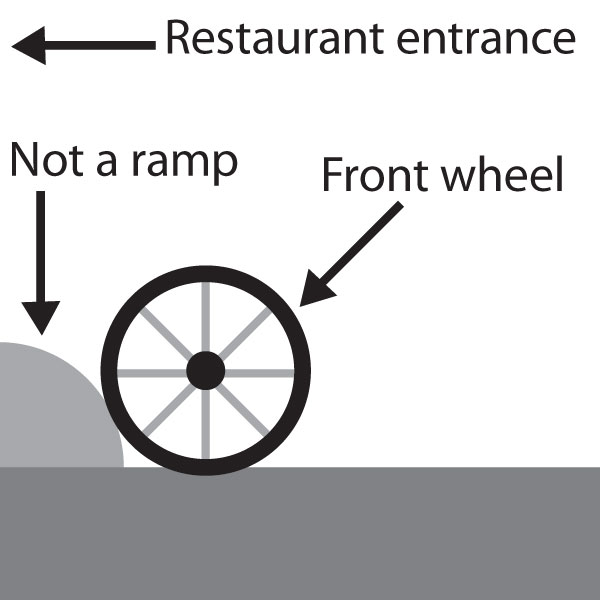
- Published: 01 March 2016
Dear Restaurateurs and Restaurant Staff,
I love eating out! I really do. Eating out lets me experience flavors, sights, and sounds from around the world. If the staff and restaurant have made for a good experience, I leave feeling satisfied, enriched, and even a little bit pampered.
But, as an individual who uses a wheelchair, I find that many of you have a bit to learn about how to make people like me feel welcome in your establishment. Unsure about how to do this? Fear not! I am here to help with a list of Top Five Things Restaurants Can Do To Make Individuals Who Use Wheelchairs Roll In. So, let’s get right into it.
- Ramp Up: Sometimes entering a restaurant can be more like mountain climbing than rolling in smoothly, if it is possible to enter at all. We wheelchair users need you to understand that when your entrance is not at the same level as the outside pavement/sidewalk, you need to provide a ramp, preferably a built-in one, so that we can enter. Too often, I have come across what I call the “Not a Ramp.” This is usually a curved hill of concrete or other flooring substance made to substitute for a ramp. As you can see from the illustration below, a wheelchair’s front tires just run into the “Not a Ramp”, and cannot get over it. Ramps are easily installed, and will be a visible invitation to people who use wheelchairs. As per the Americans with Disabilities Act (ADA):
“If a restaurant provides a ramp for its disabled patrons, the maximum slope must be 1:12 or less. Ramps have to be at least 36 inches wide with a minimum landing length of 60 inches. If a ramp is longer than 6 feet, it must have a handrail on either side that measure 34 to 38 inches in height.” (http://smallbusiness.chron.com/ada-guidelines-restaurants-23341.html)
2. The Maze Inside: Once inside certain restaurants, I have found myself having to ask other patrons to stop their meals and get up so I can pass. This frequently is accompanied by furniture being moved out of my way too. I understand that you are running a business, so the more people you can seat and serve, the better for your profit margin. But, please understand that wheelchair users do not fit into miniscule spaces at tiny tables. Wheelchairs range in width from 16 inches, for pediatric wheelchairs, to 22 inches, for adult chairs, and sometimes even wider than that. This needs to be considered when setting up your dining floor. Frequently, I find that walkways in restaurants are too tight for wheelchairs, and that wheelchair seating is relegated to the rear of the restaurant. Again, ADA concisely states:
“The aisles between fixed seats must be at least 36 inches wide, and restaurants should provide wheelchair accessible seats throughout the dining room.” (http://smallbusiness.chron.com/ada-guidelines-restaurants-23341.html)
3. Am I At The Kiddie Table?: This is a contentious point for many wheelchair users, especially me. I am 6 feet 4 inches tall, so I am in a taller wheelchair to accommodate my long legs. Now, I know when you met with your interior designer to set up your space that the lower or higher tables just looked fabulous! But, for me and other wheelchair users, it means either not fitting underneath the table, having your legs and knees crushed underneath it (This usually is what happens to me), or feeling like you’re a child sitting at the adult table for the first time because it is up so high. Additionally, we need to be able to fit underneath it AND be able to get close enough to the table/counter. The ADA has this covered too:
“To accommodate those in wheelchairs, tabletops and counters need to measure 28 to 34 inches in height. Under the table, a restaurant must provide knee room that is at least 30 inches wide, 27 inches high and 19 inches deep. Cashier and food-ordering counters must be 36 inches tall or less or have a space on the side where restaurant staff can assist customers or pass food to a customer who cannot reach over the counter. (http://smallbusiness.chron.com/ada-guidelines-restaurants-23341.html)
4. Hold it In: Something I encounter frequently is being told by restaurant staff that the restaurant is wheelchair accessible, but the bathroom is not. Oftentimes, the bathroom is downstairs. In my mind, then the restaurant is not wheelchair accessible. If all the able-bodied patrons can use the restroom, but I have to cross my legs and think happy thoughts, then that is not equal treatment, and therefore, the entire restaurant is not accessible. Plus, my wheelchair needs to not only be able to fit inside the restroom easily, but it must be able to make a 180-degree turn without obstruction. Frequently, I find that once I am in the bathroom, I cannot turn my wheelchair, there is little room left inside the bathroom, and/or there are no grab bars/handrails to help me get to the toilet. Additionally, I hate when I try to get underneath the sink to wash my hands, and I end up crushing my knees. People who use wheelchairs need space underneath the sink to access the sink. Also, I frequently find that if there is an accessible bathroom, it will sometimes be used as a storage closet, and this should never be the case. Since there is a lot of information in this area, ADA has provided a ton of simple and useful information in how you can make your bathrooms great for wheelchair users: http://smallbusiness.chron.com/ada-accessibility-guidelines-restrooms-10023.html.
5. Is There Any Way I Can Help You?: My favorite scene when I roll into a restaurant reminds me of the scenes in cartoons when the characters are confused and don’t know what to do, so they just run around banging and bumping into each other and everything around them. I have had this happen numerous times. The staff acted like a martian just landed in the middle of the restaurant, and it became a flurry of running around and flailing arms.
Please, this is THE most important point for you and your staff to know:
People in wheelchairs are PEOPLE first.
Please do not treat us like we are the aforementioned martian. Do not ask our dining partners what we want to order. Ask us. And, if you are not sure of what to do, then ask us directly. A simple, “Is there any way I can help you?” makes all the difference, and helps us maintain our dignity and gives us the option to choose what works best for us. This can make all the difference in the world.
I realize that running a restaurant is difficult, and I thank you and your staff for doing this difficult work to provide people with a great dining experience, but please consider those of us who use wheelchairs. If I have a fantastic experience in your restaurant, you can be sure that I will let other wheelchair users know that they should roll in. In turn, it becomes a win-win situation for everyone.
Yours truly,
David Friedman
The Disabled Foodie
Facebook:https://www.facebook.com/thedisabledfoodie
Tweet me: @disabledfoodie
Instagram: @thedisabledfoodie

